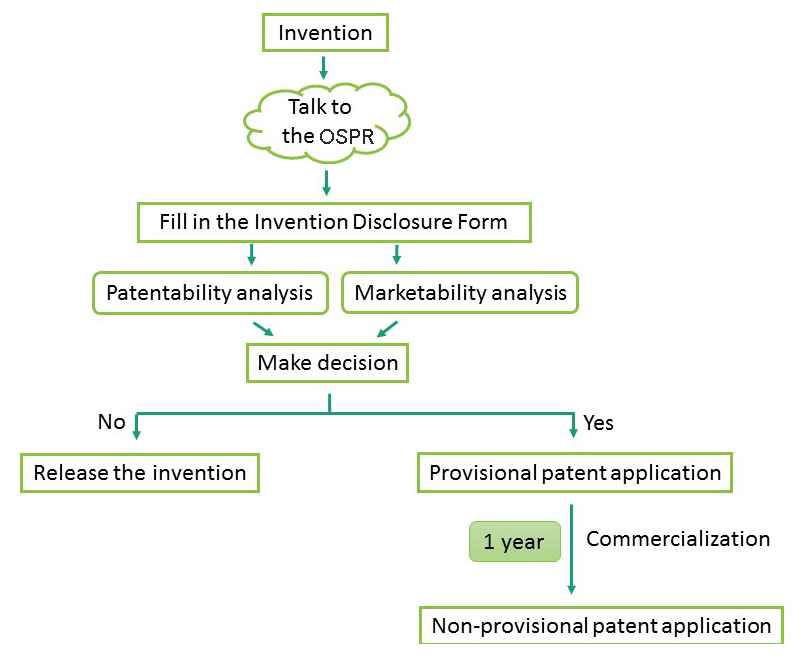Technology Transfer
The University of Louisiana at Monroe (ULM) focuses on teaching, research, and service
with a large emphasis on preparing Northeast Louisiana for enhanced productive lives. In
order to accomplish this, ULM's faculty and staff integrate these functions. Additionally,
the research performed within ULM produces invention disclosures, patent filings,
and licensing opportunities.
The Office of Sponsored Programs and Research (OSPR) is here to assist ULM's faculty
and staff with the administration and transfer of technologies to the community. If
you think you created a new invention, please complete the invention disclosure form
on the forms page and submit it to OSPR promptly.
The patent process requires accurate laboratory notebooks and institutional administration,
so be sure you remember to follow the best practices of:
- Asking yourself if the research results are patentable because of their novel characteristics;
- Report possible inventions to OSPR;
- Having transferred material agreements negotiated by OSPR so that we can protect your
intellectual property rights;
- Keep quality accurate laboratory notebooks and remember to sign and date entries;
and
- Always feel free to contact OSPR to discuss patents, licenses, or other intellectual
property matters.

Technology Development Flow Chart (provided by the University of Idaho, Office of Technology Transfer)
Issued Patents
US7713693B1: Human Cancer Cell Specific Gene Transcript (2010)
US 20110136880: Latrunculin-Based Macrolides and Their Uses (2011)
US 8,188,130 B1: Anti-cancer hydantoin compounds and methods. (Red Sea Sponge) - First
titled, Development of a novel small molecule class for the treatment of metastatic
prostate cancer (2011)
US 7,977,384 B1: Anticancer Tobacco Cembranoids (2012)
US 8,2687,86: Anti-cancer tocotrienol analogues and associated methods (2012)
US 62/508,605: Tobacco Cembranoids and Metabolites to Control Angiogenesis-Dependent
Human Pathologies (2017)
WO2018017967A1: Oleocanthal: Novel isolations and orally active self-emulsified nano-emulsion
for the prevention of breast malignancies recurrence (2018)
Regulatory Resources
Key Provisions of Bayh-Dole Act (click here for PowerPoint)
- The University is entitled to retain ownership of any inventions created as a result
of federal funding, unless the funding agency informs the University up front that
the agency will retain title to inventions derived from the funded projects because
of specifically identified “exceptional circumstances” or other specified conditions.
- When a University innovator discloses the creation of an invention derived from federally
funded research, the University has two months from that date to disclose that information
to the appropriate federal agency. The University also must patent all inventions
it elects to own and commercialize.
- The University must attempt to develop and commercialize the invention. If an attempt
is not made, the federal government retains the right to take control of the invention.
The government also may take control of the invention for other reasons,such as a
need to alleviate health or safety concerns. This provision is referred to in the
law as the government’s “march-in” rights.
- The University must provide the U.S. government with a nontransferable, irrevocable,
paid-up, nonexclusive license (“confirmatory license”) to use the invention.
- In granting a license to use the invention, the University also generally must give
priority to small businesses, while maintaining the fair-market value of the invention.
- When granting an exclusive license, the University must ensure that the invention
will be “manufactured substantially” in the United States.
- Excess revenue must support research and education.
- The University must share a portion of the royalties with the inventor(s).
Patent Search Link
https://www.uspto.gov/patents-application-process/search-patents
Trademark Search Link
https://www.uspto.gov/patents-application-process/search-patents
Copyright Search
https://www.copyright.gov/forms/search_estimate.html
National Bureau of Economic Research
http://www.nber.org/patents/
ip Handbook of Best Practices
http://www.iphandbook.org/handbook/ch09/p03/
World Intellectual Property Organization
http://www.wipo.int/edocs/pubdocs/en/licensing/903/wipo_pub_903.pdf
Licensing Consulting Group
http://licensingconsultinggroup.com/3-ways-to-negotiate-an-ip-buyout-in-your-licensing-agreement/
"IP Licenses: Restrictions on Assignment and Change of Control"
https://files.skadden.com/sites%2Fdefault%2Ffiles%2Fpublications%2FPublications2679_0.pdf
Commercialization of IP
Startup Development Program
Small Business Innovation Research (SBIR) and Small Business Technology Transfer (STTR)
Programs
"Small Business Grants: 105 Ways to Get Free Money for Your Business"

